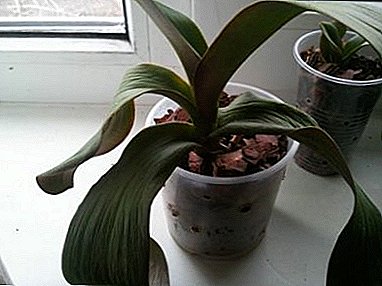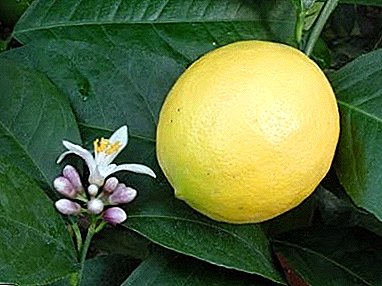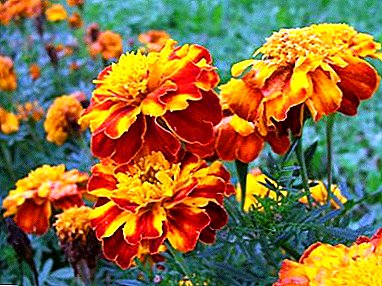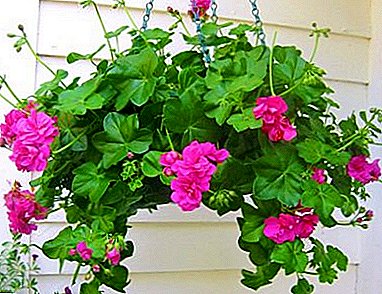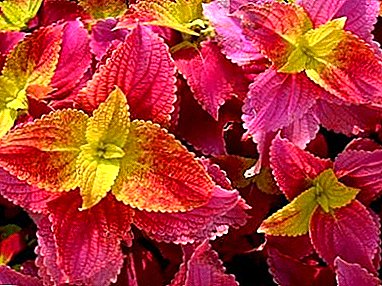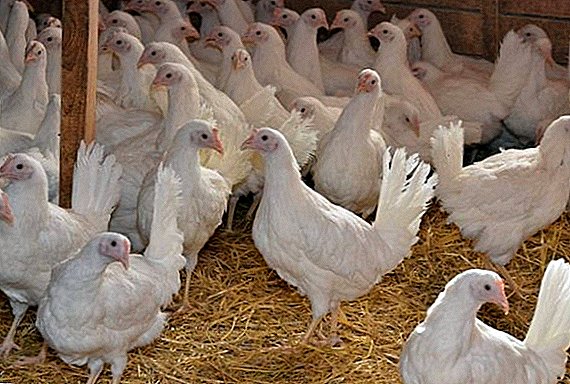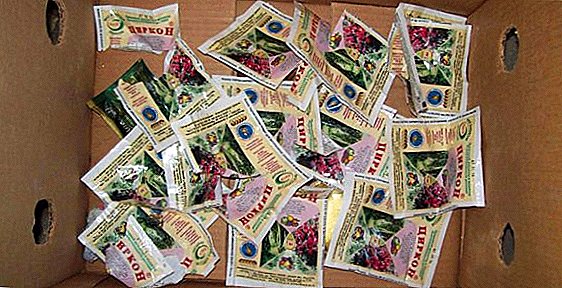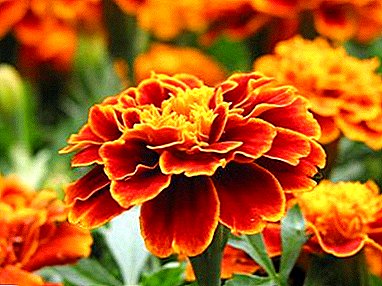
Marigolds were glorified in the songs, admired with flowers in the pictures, and also these are unpretentious plants that adorn almost every public institution of the country. Each school meeting and parting with students can not do without this fiery bloom. The flower is used for landscape ideas in a country or urban private domain. A simple and elegant plant will fill the courtyard with a heady aroma and create an atmosphere of comfort and warmth.
Where did the brightly blossoming Tagetes come from?
Marigolds belong to the family of Asteraceae or Asteraceae and are perennial or annual plants. The Latin name sounds like Tagétes and was given by Carl Liney back in 1753. The name was given in honor of the Etruscan deity Tages. The natural initial growth was in Argentina, Arizona to New Mexico. From America, transported to Spain by conquistadors in the XVI century. From this country, the flower has spread throughout Asia Minor, Russia and Europe.
A photo
How beautiful plant marigolds on a flower bed can be seen in the photo below.





Soil preparation
Marigolds are transplanted most often when the seedlings are ripe to the required size. To do this, you must first prepare in the soil, previously fertilized with humus and peat, and also dug up. Inorganic fertilizer, for example, superphosphate granules, is also allowed. Ammonium nitrate in water solution will be useful for flowers: in a bucket (10 l) of water 1 tbsp. l substances.
Can I repot during flowering?
When can a plant be transplanted in open ground and is it worth it during flowering? Marigolds are transplanted when the temperature of the environment is not lower than + 10 ° C. This will ensure stable growth and protect against possible damage and subsequent decay. Also, the development of flowers will not slow down or stop. Therefore, if the seedlings are already beginning to appear color, and the conditions on the street do not allow the transplant, you should still hold the plant before the onset of heat.
Seed germination
- Fill with substrate (loose and light) and prepare boxes.
- Make a groove in the soil mixture every 4 cm to 1 cm deep.
- To sprinkle the seeds planted with a mixture of sand and garden land. As a rule, sprouts will appear in a week.
- The first shoots should be in the temperature regime of + 22 ° С - + 25 ° С.
- The grown seedlings can develop at a temperature of + 18 ° C - + 20 ° C.
- The seedling spikes with the appearance of the first two leaves.
 An already young, grown-up plant is transferred to the conditions of open growth depending on temperature (not below + 10 ° С), as well as weather. Drops this a favorable period for marigold transplantation from the second half of April to the first part of May.
An already young, grown-up plant is transferred to the conditions of open growth depending on temperature (not below + 10 ° С), as well as weather. Drops this a favorable period for marigold transplantation from the second half of April to the first part of May.
The place of planting of the planted variety of flowers is determined in advance, since plants need space for growth.
- High varieties are placed in holes 40x40 cm.
- Medium-sized flowers are planted in 30x30 cm fossa.
- For undersized enough deepening 20x20 cm.
From the video you will learn how to sow marigolds on seedlings:
Literate transplant
The main rule of transplantation is to observe the temperature and weather conditions, as the marigolds are whimsical during this period as people from warm countries. Each shrub is examined for the presence of a well-developed rhizome and the presence of three leaves and more.
Many of the modern varieties used by this plant are hybrids; this greatly influences the subsequent collection of seeds and reproduction in this way. Next generations may differ from the mother plant.
Important conditions for the growth of Chernobrivtsev
Requirements that allow you to get the best samples of the plant:
- The place should be well lit, partial shade or full shade will limit the pomp of the plants and the brightness of the petals.
- Neutral loam is the best soil for marigolds.
- Regular watering flowers needed in the first half of summer.
- Fertilizers are replenished approximately once a month for the whole summer.
How to move to the site?
- Adhere to the scheme for the height of varieties and observe the distance between instances.
- One plant occupies a single well.
- Immediately after planting, seedlings need abundant watering.
- Duration of watering - to strengthen the stem and engraft marigolds.
Sowing directly on the flowerbed
 Reproduction of marigolds is produced by seeds, which are sown directly into the ground after the end of frost. After sprawl, bushes are thinned out or less often planted so that for each plant there is enough space for development.
Reproduction of marigolds is produced by seeds, which are sown directly into the ground after the end of frost. After sprawl, bushes are thinned out or less often planted so that for each plant there is enough space for development.
The interval to the first sunrises from the moment the seed is introduced into the soil is 40-50 days. For specific varieties this time is different. Thus, April is the most preferred period for sowing.
Marigolds give strong stalks only in fertile and loose soil. To do this, plow and add to the ground such a composition:
- Humus or compost - 1 part.
- Peat - 2 parts.
- Washed sand from the river - 0.5 parts.
In August
Can I plant them in August and how best to do it? Sowing a plant is made in any warm period and depends on the timing of the first shoots and flowering. Usually, most varieties give flowers after one and a half or two and a half months. Therefore, in mid-September, the first buds will bloom in a flower bed or in October. The first frost or temperature drop occurs already in this period. Therefore, marigolds should be planted at such a time in greenhouses or greenhouses.
Before winter
Is it possible to sow these flowers before winter?
If this period is missed, plants are planted in a greenhouse in March. However, during late landing, flowering plants are expected no earlier than June.
Reproduction by seeds in an open ground
 For planting Chernobrivtsy in open soil perform calculations in the following format:
For planting Chernobrivtsy in open soil perform calculations in the following format:
- For the appearance of the first shoots will need from 1 week.
- Flowering will be 1.5-2.5 months later.
- A favorable period with the right temperature, usually starting in mid-April.
Therefore, it should be planted from mid-late April to May. This will allow by the summer to get flowering areas and developed plants.
What rules must be observed?
Sowing directly into open ground is better suited for southern areas, since there is less chance of falling in the springtime, the temperature regime at night is lower than up to + 7 ° C.
Seeds are planted with these features:
- the soil is well loosened and fertilized;
- just before sowing, seeds are germinated;
- grooves or pits for germinated seeds will be shallow, no more than 5 cm;
- observe the availability of free space between individual plants depending on the plant variety;
- compulsory watering after planting and pouring garden soil abundant;
- diseased or weak plants are removed as soon as they are noticed.
Seeds are germinated by keeping in a damp cloth for 2-3 days under sunlight in a warm place, for example, on a window sill.
Seedlings are planted by other rules:
- For seedlings, it is important to observe the temperature regime in the first week or two after transplantation, therefore, it should not be allowed to work before the onset of stable warm weather.
- The depth of the hole for a seedling is 3-4 cm, if it goes deeper into it by 2-3 cm.
- The smallest distance between the bushes is 20 cm, 30 cm and 40 cm (determined by the selected variety and its subsequent branching).
- Laying the drainage layer to the bottom of the recess will help avoid stagnant water at the roots.
- After careful placement in the hole of the seedling need to sprinkle with soil.
- Provide optimal care for the plants.
Care for "Turkish Carnation"
Care of planted or transplanted marigolds should be carried out taking into account the following mandatory procedures:
 watering;
watering;- weeding and loosening;
- top dressing;
- trimming;
- pest prevention and control.
The care is simple and does not require much effort. First of all, it is important to supply the plant with enough moisture and fertilizer. Watering should be constantly and in moderation and with the active development and growth of plants increase the portions and frequency of watering. Rare watering begin with the onset of flowering. On hot summer days, the evening is most favorable for watering.
During periods of active development of marigolds, weeding and loosening between bushes are done. When weeding, weeds and diseased or weak plants should be removed.
Any fertilizer other than manure will help develop a strong and lush inflorescence. The most favorable periods for feeding: during transplantation or growth, in the period of tying the buds and immediately before the appearance of color.
Flowering will stop with frequent fertilizer.
View photos of marigolds, as well as find out why they sometimes do not want to dismiss the buds here.
In summer, marigold bushes can be trimmed to make their appearance more well-groomed and elegant. So new buds can form faster, and blooms become more abundant.
Due to the specific aroma of marigold flowers, most pests prefer not to spoil the flower, but when violations of the rules of cultivation appears gray mold, spider mite, snails and slugs. In the first case, the burning of an infected plant will be effective, in the second - the use of specialized means, and in the third - the manual assembly of pests. On how to protect your favorite marigolds from diseases and pests, read our material.
Conclusion
Marigold is a common and unpretentious plant in our country. It is necessary to make the correct planting of seeds, to grow strong seedlings or sprouts on open ground, to provide the necessary fertilizer and care, as well as to constantly maintain the beauty of the plantations.
These flowers grow in the shade, on poor ground without any care. However, then it is scanty flowers on thin and uneven stems, which are radically different from the picture on the packaging of even the most beautiful specimen.


 watering;
watering;